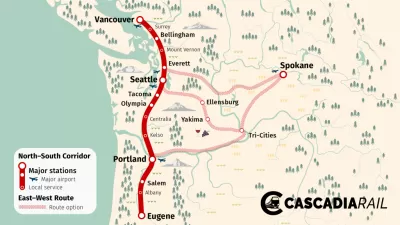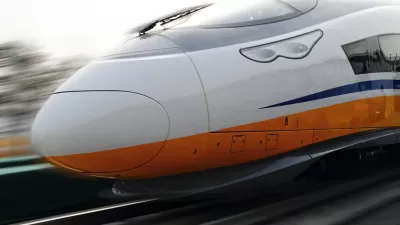The state of Washington is hoping federal infrastructure funding can pay for $198 million of the $348 million necessary to plan the Cascadia High-Speed Rail project.

Legislators in the state of Washington are applying for $198 million in federal funding from the Infrastructure Investment and Jobs act to fund planning work for a proposed 290-mile high-speed rail route connecting Portland, Oregon to Vancouver, British Columbia, with stops along the way including Seattle, Tacoma, Olympia, and more.
Mike Lindblom reports that Washington State legislators sent a letter to U.S. Transportation Secretary Pete Buttigieg making the case for the funding.
Plans call for an electric-powered system that would reach top speeds of 250 miles per hour, according to Lindblom. “The Cascadia high-speed corridor would be faster than any trains that currently operate in the United States, though contractors are now building a starter bullet-train line in central California,” according to Lindblom.
The project is still in relatively nascent stages. “So far, proponents haven’t clearly explained where to place dedicated tracks so they’re apart from other trains, motor vehicles and people, allowing 250 mph travel. That’s what a $348 million planning investment is for,” explains Lindblom.
A report on the project, submitted to the Washington State Legislature in June 2023, estimates the total cost of the project at $42 billion in 2017 dollars. However, an independent legislative review also published in June adjusted the estimate to $63 billion in 2023 dollars, based on construction inflation.
FULL STORY: WA Democrats ask Buttigieg for $200M to plan Canada-Seattle-Portland bullet train

Maui's Vacation Rental Debate Turns Ugly
Verbal attacks, misinformation campaigns and fistfights plague a high-stakes debate to convert thousands of vacation rentals into long-term housing.

Planetizen Federal Action Tracker
A weekly monitor of how Trump’s orders and actions are impacting planners and planning in America.

San Francisco Suspends Traffic Calming Amidst Record Deaths
Citing “a challenging fiscal landscape,” the city will cease the program on the heels of 42 traffic deaths, including 24 pedestrians.

Defunct Pittsburgh Power Plant to Become Residential Tower
A decommissioned steam heat plant will be redeveloped into almost 100 affordable housing units.

Trump Prompts Restructuring of Transportation Research Board in “Unprecedented Overreach”
The TRB has eliminated more than half of its committees including those focused on climate, equity, and cities.

Amtrak Rolls Out New Orleans to Alabama “Mardi Gras” Train
The new service will operate morning and evening departures between Mobile and New Orleans.
Urban Design for Planners 1: Software Tools
This six-course series explores essential urban design concepts using open source software and equips planners with the tools they need to participate fully in the urban design process.
Planning for Universal Design
Learn the tools for implementing Universal Design in planning regulations.
Heyer Gruel & Associates PA
JM Goldson LLC
Custer County Colorado
City of Camden Redevelopment Agency
City of Astoria
Transportation Research & Education Center (TREC) at Portland State University
Jefferson Parish Government
Camden Redevelopment Agency
City of Claremont




























